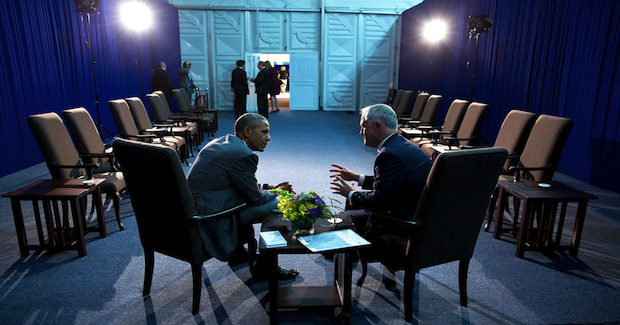Rethinking Australia's Foreign Policy

This week saw the launch of public consultation on Australia’s new foreign policy white paper. It comes at an opportune time, when the legs of the ‘tripod’ that has supported the policies of every Australian government since 1942—an alliance with a great and powerful friend, engagement with the region around us and support for a global rules-based order—are looking weaker than ever.
Late in the 20th century, threats from terrorists, cyber criminals and people smugglers began eroding the barriers between the domestic and the foreign and between state and non-state actors, forcing governments to rethink their ideas of national security: what it was, who threatened it, and how it should be secured. This was absolutely necessary.
But in the process, the broader concept of foreign policy became subsumed within a new framework of national security policy. It was dismissed as ‘diplomacy’ in contrast to a security world of harder edges and darker realities. Few of the resources that were poured into the intelligence and security agencies made their way to foreign policy. The result has been a decline in the capabilities of the Australian foreign service compared with its developed country counterparts.
Australian foreign policy has only known a globalising world. But in Europe and the United States, and in important parts of the developing world, this seems to be changing. In trade and investment trends, migration and treaty-making, there is mounting empirical evidence that globalisation is slowing.
It is clear that the US will no longer be as dominant as it was in the late 20th century.
In Asia we face a situation where, as many people have pointed out, our principal economic partner is no longer a member of the same security alliance. Successive Australian governments since the 1990s have told us that there was no need for Australia to choose between our security and our economic prosperity. In fact, we are making such choices every day and those choices are becoming more complicated.
The rules-based order seems more fragile. The purpose of that order has always been to constrain the untrammelled exercise of power by great states. But it also, inevitably, reflects their power, just as US pre-eminence shaped the structure and location of the new global institutions at the end of the 1940s.
It has been easy for Australia to support the order, because the rules have overwhelmingly been set by us and our friends. But China and other emerging countries have a growing interest in shaping the world in which they are stakeholders. In new areas like cyber and genetic engineering, norms and standards can only be set with their engagement. Australia will have to become more directly engaged in shoring up the multilateral system and establishing its new rules.
But how might a foreign policy white paper address this without being too general to be useful, or too specific to be plausible?
Few important developments in Australian foreign policy in recent years could have been foreseen by white papers—not Australia’s involvement in East Timor, or Howard’s response to the Indonesian tsunami, or Rudd’s work on the G20 leaders’ meetings. No white paper published in June 2016 would have considered the implications of the election of the Trump administration.
Defence white papers have a particular task. Multi-billion-dollar purchases of defence platforms that last for many years require extensive justification to taxpayers through a careful, formal alignment of defence strategy, capability plans and funding.
Foreign policy is different. Its broad objectives may be simply stated—advancing national interests and values—but the paths required to reach them shift continually in response to the behaviour of other actors in the international system.
To understand the world, foreign policy needs reconnaissance capabilities, found partly in overseas missions and membership of international organisations. To disseminate policy, to conciliate and persuade, it needs diplomats, not only from the Department of Foreign Affairs and Trade but from the many other government agencies now active in the business of foreign policy. It needs to be able to utilise all the potential resources of Australian soft power, outside as well as inside government, and to build them further.
Canberra’s policymakers since 1942 have differed in their objectives, energy, imagination and skill. But there has emerged an Australian foreign policy tradition with distinct and valuable characteristics.
Australian foreign policy has been global in its understanding of Australian interests, even when focusing particularly on the region. It has been active and ambitious, seeking a seat for Australia at any global or regional table and prepared, if necessary, to do the carpentry to help build it. It has been free of much romance or any sense of Australian exceptionalism. For this reason, it has been good at managing alliances and developing coalitions.
But it has also had what Gareth Evans called ‘instincts for good international citizenship’, contributing positively to the international order through a generally well-crafted aid program and significant contributions to rule-making, institution-building and peacekeeping.
That tradition is worth preserving and defending. It is another important task for the proposed white paper—to remind the Australian public of these achievements and to explain how foreign policy will navigate the uncertain and troubling terrain ahead. The hard work is just beginning.
Allan Gyngell is an adjunct professor at the Crawford School of Public Policy at the ANU and director of the Crawford Australian Leadership Forum. He was the founding executive director of the Lowy Institute for International Policy in Sydney.
The AIIA will be holding consultations for the Foreign Policy White Paper in 2017.
This article was originally published on East Asia Forum on 6 December and is republished with permission. It is based on an address delivered to the 2016 AIIA National Conference. The full transcript is available here.





